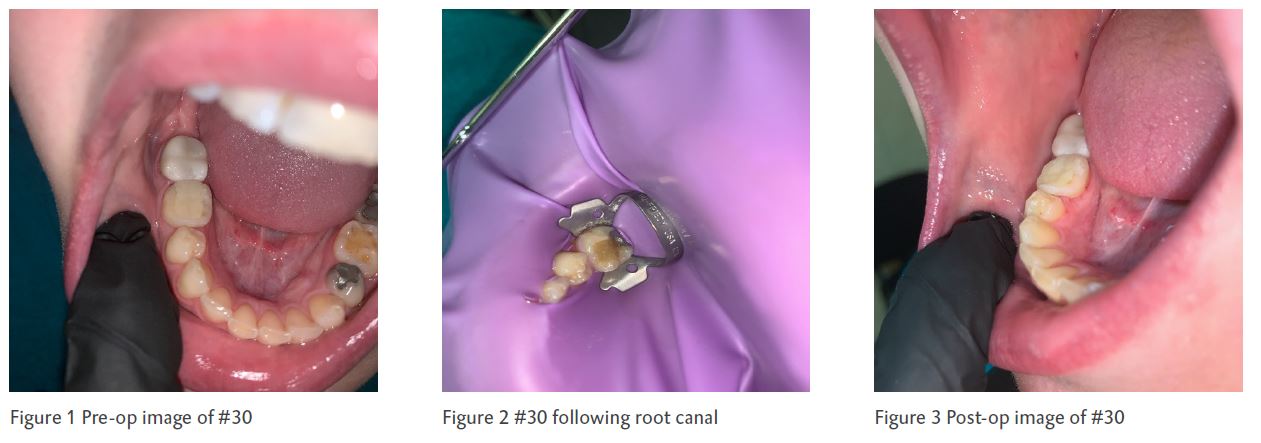by Richard L. Connelley, DMD
Introduction
As many of my colleagues have written, the ability of restorations made with DMG’s LuxaCrown long-term crown and bridge material to be long-lasting makes it an ideal solution for many patients. These include:
- Patients who need time to develop the financial means of paying for a permanent restoration
- Elderly patients who do not need – and do not want to pay for – a costly permanent restoration that could last 30 years or more
- Patients undergoing implant therapy or some other long-term treatment who need to be in an esthetic provisional state for a longer duration than a temporary restoration can support
I have found yet another use for LuxaCrown that has proven to greatly benefit many of my patients: allowing me to defer placing a permanent restoration until I am certain that the endodontic treatment, I have performed has been successful. The fact is that while an x-ray of a treated root canal may look wonderful, we have to remember that an x-ray is a two-dimensional image of a three-dimensional object. There could always be a cracked root or some other source of pain that
is undetectable by the x-ray.
When you cannot be certain about the long-term prognosis of a tooth, you owe it to your patient to buy time until you are confident you can alleviate their pain. There is nothing more embarrassing to me as a clinician than to have a patient make two or three visits for a root canal, return a few weeks later to have an expensive permanent crown placed, and then need to have the tooth extracted and replaced by an even more expensive implant because the pain has not gone away.
Case Report
A 32-year-old female patient presented complaining that she had experienced intermittent pain in her #30 lower right molar for approximately two years (Fig. 1). Upon inspection, the mesial, lingual and buccal sides of the tooth had perfect structure, but the inside of the tooth was badly infected and clearly required a root canal. I numbed the tooth using an anesthetic (Septocaine; Septodont) as a block and isolated the tooth with a rubber dam.
I then extirpated the infected nerve tissue and her amalgam filling using a #8 round bur (Brasseler). There was less blood in the canal than usual, suggesting the patient had been suffering long-term inflammation. Because this hyper-inflammation made her difficult to numb, I gave her an intra-pulpal injection of the anesthetic before doing additional extirpation. However, because she was still feeling some pain, I stopped and had her return in two weeks to complete the procedure. By that time, the inflammation had been reduced to the point that I was able to achieve sufficient numbness and finish the root canal procedure (Fig. 2).
At that point, LuxaCrown afforded me two chairside options: fabricating a long-lasting crown, or fabricating an MODBL onlay. Because the rest of the tooth was so healthy, I opted to go with the onlay because it would allow me to conserve more of the tooth structure.
I simply filled the tooth with the LuxaCrown, which acted as its own baseliner, overlapping all five of the tooth’s cusps. Importantly, I allowed the LuxaCrown to fill in all the undercuts all the way down the tooth chamber and to overlay the lingual, buccal and mesial surfaces. I then shaped the onlay using a 5856 diamond bur (Brasseler) and then did some polishing and additional shaping using a football-shaped carbide bur (Brasseler). From an esthetic standpoint, the LuxaCrown finished so beautifully that the onlay looks just as natural as a porcelain or zirconia onlay fabricated in a lab.
Two months post-treatment the patient reported feeling no pain in the tooth for the first time in over two years. In addition, the contact between #30 and #31 was perfect; had I used another non-permanent material instead of LuxaCrown, I suspect the contact would have already started to open up.
Comments
It is impossible to know exactly what eliminated the pain; it could have been the removal of the infected nerves, or that the LuxaCrown filled in an unseen fracture or two in the cusps, or some combination of the two. There is no way to know for certain. And that is precisely the point: X-rays often do not allow you to accurately diagnose the cause of a patient’s pain, so why subject the patient to a costly permanent restoration – or an even costlier implant – when there is no way to be certain it will solve the problem? In short, going with an affordable long-lasting crown or a long-lasting onlay buys you time before locking the patient into a permanent restoration. In this particular case, the patient retains the option of a permanent restoration down the road, but it will not surprise me if she never needs to have her onlay replaced.
Author Bio
Richard Connelley, DMD, owns and runs general practices in Salyersville and Paintsville, Kentucky. He is a 1979 graduate of the University of Kentucky College of Medicine.

